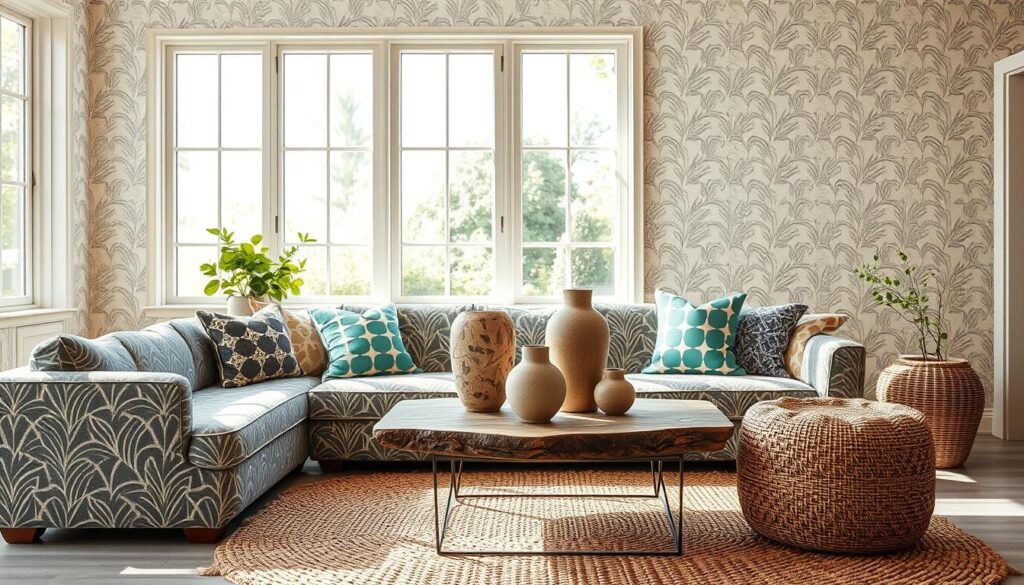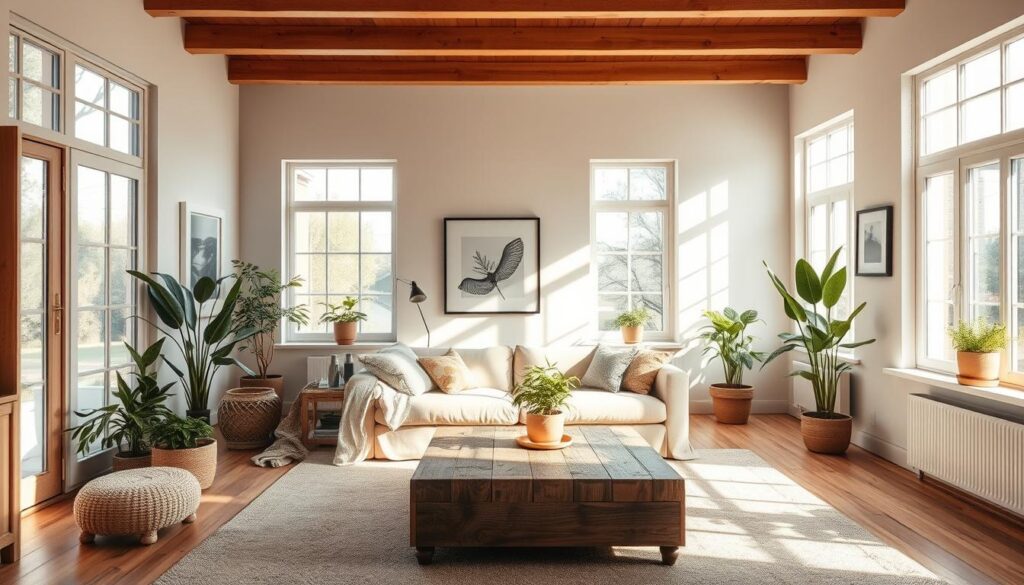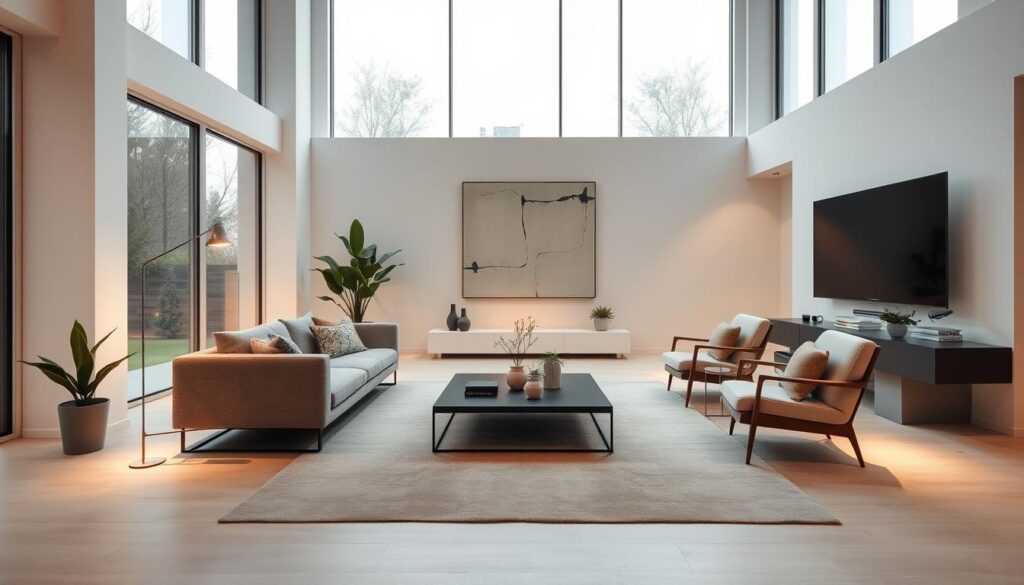Did you know a well-designed living space can make you happier and more productive? At oomph, we’re not just makers of bespoke furniture. We’re interior design experts who love helping you create a space that’s truly yours!
Improving your home’s aesthetic might seem hard, but with the right help, it’s a fun journey. We focus on making a space that shows off your unique personality and style. Our tips and tricks will guide you to a home that looks great and feels like you.
Key Takeaways
- Discover expert tips for elevating your home’s aesthetic
- Learn how to create a cohesive and stylish look
- Understand the importance of reflecting your personality and style in your home
- Get guidance on achieving a modern interior design
- Explore home decor ideas that inspire you
Understanding the Basics of Interior Home Design
Interior home design is all about making a space look good and work well. A good plan is your guide, showing you how to decorate. Think about your lifestyle and what you like, then start designing.
Key Principles of Design
The basics of design are key to a great home. These include balance, proportion, emphasis, movement, pattern, unity, and contrast. Knowing these helps you make a space that looks and feels right. For example, balance can be even or uneven, and proportion is about furniture size.
- Balance: Symmetry or asymmetry
- Proportion: Size and scale of furniture and decor
- Emphasis: Creating a focal point
- Movement: Guiding the eye through the space
Color Theory in Interior Design
Color theory is vital in design, affecting a room’s feel and look. Knowing the color wheel and how to use it is key. We can pick colors that work well together, making a room feel right. For modern homes, a single color or a bold wall can really stand out.
- Understanding the color wheel
- Selecting a color scheme
- Using color to create ambiance
The Importance of Space Planning
Space planning is crucial for a room that works and feels good. It’s about the room’s layout, how people move, and where furniture goes. Good planning makes sure the space fits our needs and improves our life.
To do this, measure the room, think about what you’ll do there, and pick furniture that fits. Looking at how others use their space can also help.
Creating a Focal Point in Every Room
Designing a room means making a focal point to catch the eye. This can be a big piece of art, a bold wall color, or a special furniture setup. A focal point adds interest and personality to our rooms.
Using art and decor is a great way to make a focal point. A big art piece or a group of smaller ones can make a room stand out. Decor items like vases or sculptures can also create a striking focal point.
Utilizing Artwork and Décor
Art and decor are key in making a focal point. A bold art piece can be the room’s centerpiece. A gallery wall of smaller art can also catch the eye. Pick art that fits the room’s colors and style.
“The right piece of art can transform a room, making it feel more personal and inviting.”
To use art and decor well, remember these tips:
- Choose pieces that show your style and match the room’s decor.
- Try different setups to find the best look.
- Think about the size of the art or decor compared to the room and furniture.
Furniture Arrangements to Draw Attention
Furniture setup can also highlight a room’s focal point. Arranging furniture to focus on a spot adds interest. For example, a brightly colored sofa or a unique coffee table in a key spot can grab attention.
| Furniture Arrangement | Effect on Room |
|---|---|
| Symmetrical arrangement | Creates a sense of order and calm |
| Asymmetrical arrangement | Adds visual interest and energy |
| Circular arrangement | Encourages conversation and flow |
By carefully arranging furniture and adding art and decor, we can highlight a focal point. This makes our rooms more welcoming and shows off our style.
Choosing the Right Color Palette for Your Home
Choosing the right colors is key in interior home design. The colors you pick greatly affect your home’s feel. It’s important to choose colors that match your style and your home’s look.
Exploring color palettes means looking at current trends and timeless rules. A good color scheme can make your home look better. But, a bad one can make it look worse.
Trends in Color for 2023
2023’s color trends offer many inspiring choices. Some top picks include:
- Earth tones like sage green and sandy beige, which add calm and natural beauty.
- Rich jewel tones such as emerald green and navy blue, adding depth and luxury.
- Soft pastels like pale pink and baby blue, creating a romantic feel.
These trends can help start your color palette. But, it’s key to pick colors that you love and fit your home.
How to Pick Complementary Colors
Finding complementary colors is an art. It involves color theory and your design needs. Here are tips for choosing colors that go well together:
| Color Combination | Description | Effect |
|---|---|---|
| Monochromatic | Using different shades of the same color | Creates a cohesive, harmonious look |
| Complementary | Pairing colors opposite each other on the color wheel | Adds contrast and visual interest |
| Analogous | Selecting colors next to each other on the color wheel | Produces a smooth, natural transition between colors |
Testing Paint Samples Effectively
After choosing colors, test paint samples on your walls. This step helps avoid regrets and ensures the color looks good in different lights.
To test paint samples well, paint small wall sections with your chosen colors. See how they look at different times and under various lights. This helps you understand how the color will look in your home.
By looking at current trends, picking complementary colors, and testing paint samples, you can create a beautiful color palette. It will reflect your style and make your home look great.
The Role of Lighting in Home Design
Lighting is key in home design, affecting both the feel and use of a space. It’s not just about light; it’s about making a space feel right. Knowing about different lighting types helps create a welcoming and well-lit area.
Different Types of Lighting Fixtures
There are many lighting fixtures for different effects in a room. These include:
- Ambient lighting, which gives overall light
- Task lighting, for specific tasks like reading or cooking
- Accent lighting, to highlight certain features or areas
Combining these lighting types adds depth and interest to a room. It makes the space more engaging and useful.
Layering Lighting for Effect
Layering lighting means using different light sources at various levels. This includes overhead lights, table lamps, and floor lamps. It helps control the mood and focus on specific areas in a room.
Effective layering makes a room lively and interesting. It also provides the right light for different activities.
Natural Light Considerations
Natural light is vital in home design, affecting the feel and use of a space. Using big windows, skylights, or mirrors can brighten a room. It makes it feel more open and welcoming.
When planning your lighting, balance natural and artificial light. This balance is crucial for contemporary home interiors that look good and work well.
By using these lighting strategies, you can improve your home’s look and function. It shows the latest interior design inspiration.
Selecting Appropriate Furniture Styles
The right furniture can make your home look better and feel welcoming. Choosing the right furniture is key to a room that looks good and works well. It sets the mood and style of your living space.
When picking furniture, think about your home’s style, the room’s use, and what you like. Let’s look at some important things to consider for good choices.
Modern vs. Traditional Furnishings
First, decide between modern or traditional furniture. Modern furniture has simple designs and focuses on being useful. Traditional furniture has fancy details and is all about comfort. You can pick one or mix them for a look that’s all you.
For ideas on mixing styles, check out different interior design styles. They can help you balance modern and traditional in your home.
Sustainable Furniture Options
Now, there’s a big push for eco-friendly furniture. This furniture is made from green materials, lasts long, and is good for the planet. Choosing it makes your home stylish and green.
Custom vs. Ready-Made Pieces
Next, think about custom versus ready-made furniture. Custom furniture fits your space perfectly, but it’s pricier. Ready-made furniture is cheaper and quicker to get, but might not fit as well. Think about what you need for your home.
By picking furniture that fits your style and needs, you’ll have a home that’s both beautiful and useful. Enjoy it for many years.
Incorporating Texture and Patterns
Texture and patterns are key in modern interior design. They add depth and character to any room. By mixing textures and patterns, we can create a space that shows our style.
Mixing Textures for Depth
Mixing textures adds depth to a room. Smooth textures like glass or metal work well with rough textures like wood or woven fibers. For example, a sleek leather sofa with a chunky woven rug can make your living room interesting.
To mix textures well, know the 5 main types: smooth, rough, soft, hard, and matte. Balancing these can create a cohesive look. Here’s a simple guide to get you started:
| Texture Type | Examples | Best Used With |
|---|---|---|
| Smooth | Glass, Metal, Polished Wood | Rough, Soft |
| Rough | Woven Fibers, Reclaimed Wood | Smooth, Hard |
| Soft | Plush Rugs, Velvet Furniture | Hard, Matte |
Using Patterns to Enhance Design
Patterns add visual interest and personality to a room. It’s important to balance bold and subtle patterns. For example, a bold rug with subtle curtains can look great together.

To use patterns well, follow the 60-30-10 rule. 60% of the room should have a dominant pattern, 30% a secondary, and 10% an accent. This keeps the space balanced and interesting.
The Importance of Fabric Choice
Fabric choice is crucial for a room’s look and feel. It’s not just about looks; it’s also about function. For example, durable, stain-resistant fabrics are great for busy areas.
When picking fabrics, think about texture, pattern, and color. Mixing fabrics can make furniture and decor more interesting. For example, linen curtains with velvet upholstery can add luxury to a room.
Personalizing Your Space with Accessories
The right accessories can turn a house into a home that shows your personality. Adding personal touches makes your space unique and welcoming.
Essential Accessories to Boost Design
Choosing the right accessories is key in interior decorating. Add pieces like vases, sculptures, or artwork that speak to you. For example, a bold piece of art can be a room’s centerpiece, adding character and depth.
“The little things are not the little things; they are the details that make the design.” This quote highlights how accessories enhance your home’s design.
Creative Ways to Display Personal Items
Displaying personal items adds a personal touch to your space. You can create a gallery wall with family photos, travel souvenirs, or meaningful objects. Or, use decorative shelves or mantels to showcase your favorites.
- Use decorative boxes or baskets to store small personal items, keeping them organized and on display.
- Create a vignette on a coffee table or side table with items that tell a story or reflect your interests.
- Hang a collection of framed prints or artwork to add visual interest to a room.
By carefully choosing and displaying personal accessories, you can make a space that’s both stunning and meaningful. For more inspiration, explore different styles and trends to find what suits you best.
Sustainable Interior Design Practices
Nowadays, we focus more on saving the environment. This means using eco-friendly design in our homes. It’s about making our spaces better for us and the planet.
Choosing the right materials is key in sustainable design. Eco-friendly materials are good for the earth. They include things like reclaimed wood, bamboo, and paints that don’t harm the air. These choices help make our homes greener.
Eco-Friendly Materials to Consider
There are many green materials for our homes. Reclaimed wood adds charm and saves trees. Bamboo is great for floors and furniture because it grows fast.
It’s also important to pick paints and finishes that don’t pollute. Low-VOC paints come in many colors. They let us decorate without harming our health or the planet.

Energy-Efficient Design Solutions
Using less energy is vital for our planet. Good lighting is a big help. Energy-efficient lighting like LEDs uses much less power. Plus, using more natural light cuts down on artificial light needs.
Interior designer Janie Molster says homes need to be green and strong. She helps make homes ready for storms. Her work shows how important green design is.
“Sustainability is no longer a choice but a necessity in modern interior design.”
By choosing green design, we help the planet and make our homes better. Using eco-friendly stuff and smart lighting are just a few ways to make a difference.
Tips for Maintaining Your Interior Design
To keep our homes looking great, we need to update our interior design often. This means changing our décor, taking care of our furniture, and making seasonal updates. Doing this keeps our homes a true reflection of our style and taste.
Refresh Your Décor
Updating our home decor can be easy. Just swap out throw pillows, move furniture around, or add new artwork. These small steps can greatly improve our home’s look, making it feel new and modern.
Care for Your Furnishings
It’s important to clean and care for our furniture properly. Following the manufacturer’s cleaning tips and using the right products helps our furniture last longer. This way, our furniture stays in top condition.
Make Seasonal Changes
Adding seasonal decorations and changes keeps our homes lively and current. Whether it’s winter throws or summer flowers, these touches greatly enhance our interior design.


